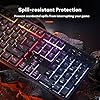Table of Contents
Introduction to Learning Piano by Analyzing Famous Pianists
Learning to play the piano can be a rewarding and enriching experience, especially when it involves studying the techniques and styles of some of the world’s most famous pianists. By analyzing the performances and methodologies of legendary artists, aspiring pianists can gain invaluable insights and inspiration that can significantly accelerate their learning process. This approach not only enhances technical skills but also deepens an understanding of different musical genres and historical contexts.
Studying the Techniques of Renowned Pianists
Learning piano by analyzing famous pianists involves a deep dive into various techniques employed by these masters. By studying their approaches, students can discover unique methods that can enhance their own playing style.
Logitech MK270 Wireless Keyboard and Mouse Combo for Windows, 2.4 GHz, 8 Multimedia Keys, PC, Laptop, Wireless Keyboard Compact Mouse Combo - Black
23% OffRedragon K521 Upgrade Rainbow LED Gaming Keyboard, 104 Keys Wired Mechanical Feeling Keyboard with Multimedia Keys, One-Touch Backlit, Anti-Ghosting, Compatible with PC, Mac, PS4/5, Xbox
20% OffLogitech K270 Wireless Keyboard for Windows, 2.4 GHz Wireless, Full-Size, Number Pad, 8 Multimedia Keys, 2-Year Battery Life, Compatible with PC, Laptop, Black
33% OffEPOMAKER x Aula F75 Gasket Mechanical Keyboard, 75% Wireless Hot Swappable Gaming Keyboard with Five-Layer Padding&Knob, Bluetooth/2.4GHz/USB-C, RGB (Light Blue, LEOBOG Reaper Switch)
13% OffKnown for his exceptional Bach interpretations, Glenn Gould utilized distinctive finger technique and minimal body movement. This approach emphasizes precise finger placement and economy of motion, which can be particularly beneficial for playing complex baroque compositions.
Martha Argerich is celebrated for her spontaneous and emotionally engaging performances. Studying her playing can help pianists learn how to connect more deeply with the music and communicate that emotion effectively to an audience.
Known for his technical perfection, Arturo Benedetti Michelangeli adopted an approach of absolute precision and clarity. Focusing on his recordings provides insights into achieving impeccable technical control and nuance in performance.
Oscar Peterson, a giant in the jazz world, utilized a remarkable blend of speed, precision, and rhythm. Jazz pianists or classical pianists interested in jazz can learn tremendously from his improvisation skills and swing feel.
RockJam RJ761 61 Key Keyboard Piano with Keyboard Bench, Digital Piano Stool, Sustain Pedal, Headphones & Lessons
$159.85 (as of December 20, 2025 22:54 GMT -08:00 - More infoProduct prices and availability are accurate as of the date/time indicated and are subject to change. Any price and availability information displayed on [relevant Amazon Site(s), as applicable] at the time of purchase will apply to the purchase of this product.)Donner DDP-300 Digital Piano with 88 Graded Hammer Action Weighted Keys, Record, Bluetooth, 10 Voices, 4 Reverb, Speakers, Professional Full Fize Key Keyboard Electric Dark Rose
17% OffDonner DEP-20 Beginner Digital Piano 88 Key Full Size Weighted Keyboard, Portable Electric Piano with Furniture Stand, 3-Pedal Unit
15% OffYAMAHA P71 88-Key Weighted Action Digital Piano with Sustain Pedal and Power Supply (Amazon-Exclusive)
6% OffDaniil Trifonov introduces modern interpretations into traditional compositions. Exploring his performances helps learners understand how contemporary expressions and classic techniques can coexist beautifully.
Yuji Takahashi is known for exploring avant-garde pieces and integrating electronic music with traditional piano playing. His work is beneficial for students looking to expand beyond classical repertoire and into more experimental music.
Lang Lang offers a unique blend of technical proficiency and charismatic stage presence. His performances are a lesson in how to captivate an audience not just with skill but also with dynamic presentation and energy.
How to Apply Their Methods to Your Practice
Study Their Performances: Begin by watching videos or live recordings of famous pianists. Focus on their hand movements, posture, and facial expressions. Try to notice subtle nuances like the timing of their finger presses in relation to the melody and rhythm. Apply these observations by mimicking these movements and expressions in your practice sessions to incorporate their style and technique into your playing.
Analyze Their Choice of Dynamics: Famous pianists have a unique way of utilizing dynamics to express emotions through music. Pay close attention to how they vary their volume and intensity throughout a piece. Record yourself playing the same piece and compare it to their performance, making note of differences in dynamics. Gradually adjust your playing to introduce more dynamic variation inspired by their interpretations.
Interpret Their Use of Tempo: Tempo manipulation is another critical aspect where you can learn a lot. Notice how they may speed up or slow down at certain parts of a piece to add expressive depth or build tension. Practice these variations yourself by using a metronome to achieve precision at first, and then freely experiment with tempo changes while maintaining the piece’s integrity.
Learn From Their Mistakes: Even the greatest pianists make mistakes during performances. Studying how they recover can teach you about resilience and adaptability in playing. During practice, instead of stopping after a mistake, continue playing and find ways to seamlessly correct errors. This builds confidence and improves your live performance skills.
Emulate Their Practice Routines: Research or read interviews to learn about the practice routines of these artists. Many famous pianists emphasize the importance of scales, arpeggios, and finger strengthening exercises. Incorporate similar routines into your practice, dedicating time to improve technique, agility, and finger independence.
Explore Their Musical Interpretations: Look into how these pianists interpret the same piece differently from others. This might involve emphasizing different notes, altering phrasing, or experimenting with harmonic colors. Try to apply these interpretations to your playing, experimenting with different ways to play a piece until you find one that resonates with your artistic voice.
Utilize Masterclasses and Tutorials: Many renowned pianists offer masterclasses and tutorials online, either free or paid. Participate in these sessions to gain direct insights from the experts. Apply the tips and techniques discussed during these classes in your practice to refine your skills further.
Learn About Their Background and Influences: Understanding the historical and cultural background of these pianists can provide deeper insights into their playing style and musical choices. Study their influences, training, and the era they performed in, and reflect on how these factors shaped their music. Use this knowledge to inform your interpretations and add depth to your performances.
Watching Performances to Understand Interpretation
When learning piano by analyzing famous pianists, watching their performances is crucial to understand the nuances of musical interpretation. This method allows students to see real-time applications of technique, emotion, and stylistic choices that define each pianist’s unique approach to the same pieces of music.
Observing Technique and Expression
Viewing live performances or recorded videos of pianists such as Lang Lang, Yuja Wang, or Martha Argerich can be immensely educational. Pay attention to how these pianists manage their finger technique and the expressivity of their playing. Observing their hand movements, the way they articulate notes, and their pedal usage can provide insights on the mechanical execution of complex pieces.
Interpreting Musicality and Phrasing
A crucial aspect of piano interpretation is understanding the phrasing and musicality that top artists bring to their performances. Watch how pianists emphasize certain notes, how they handle transitions between phrases, and their dynamic choices. Students can gain a deeper understanding of musical phrasing and learn to develop their own expressive capabilities.
Studying Emotional Engagement
Emotional engagement is often what separates the great from the good. By studying how accomplished pianists convey emotions, learners can enhance their emotional connection to the music. Note the subtle facial expressions, body language, and even slight pauses they use to convey the mood of the piece.
Assessing Interpretative Choices
Each pianist brings a personal touch to the pieces they play, which can manifest in tempi, dynamics, and rhythm. Analyzing these choices gives students examples of how much personal interpretation is possible within the confines of classical music, encouraging them to experiment in their playing.
Learning Through Repetition
Repeated viewing of the same performance can uncover layers of interpretation that may not be apparent on the first watch. This repetition allows learners to dissect performances in a way that reading sheet music alone cannot provide.
Breaking Down Signature Pieces from Great Pianists
Understanding the nuances and trademark styles of accomplished pianists through their signature pieces can offer invaluable lessons for aspiring musicians. Here, we explore some iconic pieces associated with great pianists and the unique aspects they bring to their performances.
Glenn Gould – Bach’s Goldberg Variations
Glenn Gould’s interpretation of Bach’s Goldberg Variations, particularly his 1955 recording, stands as a monumental achievement in piano playing. Gould’s approach is noted for its remarkable clarity, speed, and precision. Key aspects to study here include his distinctive articulation, use of counterpoint, and minimal pedal. The variations are not only technically demanding but also require a deep understanding of Bach’s compositional language, which Gould navigates with extraordinary intellect and emotional depth.
Martha Argerich – Prokofiev’s Piano Concerto No. 3
Martha Argerich’s performance of Prokofiev’s Piano Concerto No. 3 is renowned for its fiery technique and expressive depth. Argerich brings an explosive energy to the piece, combined with a spontaneous lyrical quality that highlights the contrast between Prokofiev’s abrasive modernism and melodic passages. Pianists studying this piece should pay attention to the integration of a strong rhythmic drive with intricately sculpted phrasings.
Arturo Benedetti Michelangeli – Debussy’s Images
The playing of Arturo Benedetti Michelangeli illuminates the subtlety and impressionistic color of Debussy’s Images. Known for his meticulous attention to detail and crystalline sound, Michelangeli explores a spectrum of dynamics and tonal colorations, providing a masterclass in touch and pedal use. These pieces require a nuanced balance between technical precision and atmospheric portrayal, making them stellar studies in expression and control.
Vladimir Horowitz – Chopin’s Ballade No. 1
Vladimir Horowitz’s rendition of Chopin’s Ballade No. 1 is celebrated for its dramatic narrative and virtuosic flair. Horowitz showcases a profound understanding of Chopin’s romantic style, characterized by its rich tonal palette and dynamic contrasts. Aspects vital for analysis include his timing and pacing that brilliantly mirror the emotional swells and declines within the piece, along with a masterful deployment of Rubato.
Lang Lang – Liszt’s La Campanella
Lang Lang’s performances of Liszt’s technically challenging La Campanella highlight his virtuosic skill and charismatic stage presence. His interpretation is admired for its adventurous tempos and theatrical dynamics, making the composition come alive with excitement and flair. Aspiring pianists can learn about harnessing technical prowess to serve expressive goals, focusing on passages that demand delicate fingering alongside grand, sweeping gestures.
Each of these pianists brings a distinct interpretative approach to their signature pieces, offering a diverse range of styles and techniques for students to analyze and emulate in their quest to master the piano.
Incorporating Professional Techniques into Your Playing
Studying the performances and recordings of famous pianists can be incredibly beneficial for developing your own piano skills. Incorporating professional techniques into your playing can elevate your musical expression and technical proficiency. Here, we will explore some specific techniques used by professional pianists that you can start integrating into your practice routine.
Use of Pedaling
Pedaling is not just about sustaining notes; it’s an art that affects the texture and color of the music. Observing how renowned pianists manage the sustain and damper pedals during different musical passages can provide insights on achieving nuance in your playing. Practice by trying different pedaling techniques like the half-pedal and flutter pedaling to see how they change the sound palette of pieces you are working on.
Phrasing and Expression
Listen to how famous pianists phrase melodies and handle dynamics. Mimicking their approach can help you understand deeper layers of a piece. Focus on the emotional delivery and dynamic contrasts, and experiment with pushing or pulling the tempo slightly to enhance musical expression. This technique, known as rubato, can help in making your performances more captivating.
Articulation and Touch
Piano touch refers to how a pianist presses the keys, which affects the tone and articulation of each note. Watch videos of pianists and note whether they are using a soft, firm, or sharp touch for different styles or pieces. Incorporating varied articulation modes like staccato, legato, and accented play can also be critical in shaping your interpretation of any piece.
Fingering Techniques
Fingering is key to fluidity and speed in piano playing. Trying the fingerings preferred by expert pianists, especially in complex passages, may enhance your technical ability and playing speed. Always consider how the fingering affects the ease of play and the musical phrasing. This might require adapting your technique considerably and consistently practicing new fingering patterns.
Utilizing Body Movements
Observe the body language and movements of seasoned pianists. Efficient use of body movements can greatly improve your stamina and reduce the risk of injury. Pay attention to how they position their bodies, use shoulder movements, and distribute weight across their hands. This ergonomic approach to playing is crucial for playing more demanding works and for long-term playing health.
Understanding the Historical Context
Knowledge of the historical context of pieces provides insights into the intended style and emotional undertones. Research how pianists who specialize in different eras (Baroque, Classical, Romantic, etc.) approach their interpretations. This understanding can inform the stylistic choices you make in your playing, from tempo to ornamentation, aligning your performance with the period’s characteristics.
Learning from Collaborations
Professional pianists often engage in collaborations with other musicians. This interaction can inspire nuances in timing, dynamics, and expression that are crucial in ensemble settings but also applicable to solo performances. If possible, take opportunities to play with others, whether in duets, bands, or larger ensembles, to incorporate responsive timing and adaptability into your playing style.
Conclusion
In sum, the study of famous pianists provides invaluable lessons for aspiring musicians. By examining their methodologies, interpretations, and personal practice habits, learners can enhance their own technique and expressive capacity. Emphasizing the importance of persistence, personalized learning strategies, and emotional connection to music, these insights assist in creating a more thoughtful and effective practice regimen. Notably, the diverse backgrounds of these artists showcase that dedication, passion, and continuous learning are quintessential to mastering the piano, regardless of one’s initial skill level or inherent talent.





























































